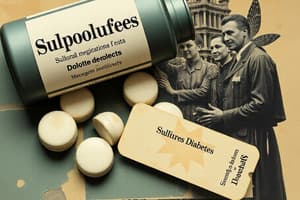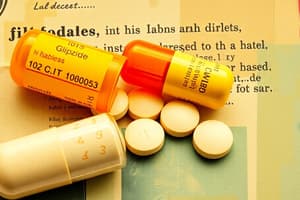Podcast
Questions and Answers
What is the primary mechanism of action for Biguanides, such as Metformin, in managing hyperglycemia?
What is the primary mechanism of action for Biguanides, such as Metformin, in managing hyperglycemia?
- Increasing glucose reabsorption in the kidneys to reduce glucose excretion in urine.
- Inhibiting the breakdown of GLP-1 to prolong its activity and enhance insulin secretion.
- Suppressing hepatic gluconeogenesis, thus reducing glucose production by the liver. (correct)
- Stimulating insulin release from pancreatic Beta cells, irrespective of blood glucose levels.
Which factor is most critical to consider before initiating treatment with a Sulfonylurea, such as Glipizide, in an elderly patient with type 2 diabetes?
Which factor is most critical to consider before initiating treatment with a Sulfonylurea, such as Glipizide, in an elderly patient with type 2 diabetes?
- The patient's risk for hypoglycemia and the potential impact on their cognitive and cardiovascular health. (correct)
- The patient's preference for oral medications over injectables and their willingness to adhere to the regimen.
- The patient's kidney function and the need for dose adjustments to prevent lactic acidosis.
- The patient's BMI and the potential for weight gain associated with sulfonylurea use.
What is the primary reason to avoid combining a Sulfonylurea with a GLP-1 Receptor Agonist?
What is the primary reason to avoid combining a Sulfonylurea with a GLP-1 Receptor Agonist?
- The combination significantly elevates the risk of hypoglycemia without additional benefit in glycemic control. (correct)
- The combination significantly increases the risk of severe hyperglycemia due to opposing mechanisms of action.
- The combination leads to unpredictable fluctuations in blood glucose levels, making glycemic control difficult.
- The combination increases the risk of pancreatitis and pancreatic cancer compared to either drug alone.
A patient with type 2 diabetes is started on a SGLT2 inhibitor. What is the most important counseling point regarding potential side effects?
A patient with type 2 diabetes is started on a SGLT2 inhibitor. What is the most important counseling point regarding potential side effects?
How do GLP-1 receptor agonists (e.g., liraglutide, semaglutide) contribute to glycemic control beyond stimulating insulin release?
How do GLP-1 receptor agonists (e.g., liraglutide, semaglutide) contribute to glycemic control beyond stimulating insulin release?
What is the most critical monitoring parameter for patients taking Metformin, particularly those with pre-existing renal impairment?
What is the most critical monitoring parameter for patients taking Metformin, particularly those with pre-existing renal impairment?
Why should the use of thiazolidinediones (TZDs) like pioglitazone be approached with caution, or avoided altogether, in patients with heart failure?
Why should the use of thiazolidinediones (TZDs) like pioglitazone be approached with caution, or avoided altogether, in patients with heart failure?
In a patient with type 2 diabetes and established atherosclerotic cardiovascular disease, which class of antihyperglycemic medications is generally preferred due to its cardiovascular benefits?
In a patient with type 2 diabetes and established atherosclerotic cardiovascular disease, which class of antihyperglycemic medications is generally preferred due to its cardiovascular benefits?
What is the rationale behind using inhaled insulin in some patients with diabetes, and what is a major limitation associated with its use?
What is the rationale behind using inhaled insulin in some patients with diabetes, and what is a major limitation associated with its use?
A patient with longstanding type 2 diabetes is on maximum tolerated doses of metformin and a GLP-1 receptor agonist, but their HbA1c remains above target. What would be the most appropriate next step in managing their hyperglycemia?
A patient with longstanding type 2 diabetes is on maximum tolerated doses of metformin and a GLP-1 receptor agonist, but their HbA1c remains above target. What would be the most appropriate next step in managing their hyperglycemia?
Flashcards
Dipizlimab's Effect
Dipizlimab's Effect
Dipizlimab delays the onset of Type 1 Diabetes Mellitus (T1DM).
Hyperglycemic Hyperosmolar Syndrome (HHS)
Hyperglycemic Hyperosmolar Syndrome (HHS)
Hyperglycemic Hyperosmolar Syndrome (HHS) is characterized by high blood sugar and increased blood osmolarity.
A1C Target
A1C Target
A1C target of <7% is generally recommended.
Device Data Collection
Device Data Collection
Signup and view all the flashcards
Glucose Rounding
Glucose Rounding
Signup and view all the flashcards
Splitting Insulin Doses
Splitting Insulin Doses
Signup and view all the flashcards
GLP-1 RAs Action
GLP-1 RAs Action
Signup and view all the flashcards
SGLT2 Inhibitors
SGLT2 Inhibitors
Signup and view all the flashcards
Metformin's Action
Metformin's Action
Signup and view all the flashcards
Microvascular Complications
Microvascular Complications
Signup and view all the flashcards
Study Notes
Sequence Guidance Documents
- A learning guide lists course objectives, reading assignments, and sequence activities
Objectives In General
- Appropriately monitoring, counseling, and treating diabetes complications is essential, including HTN, HLD, CKD, antiplatelet use in primary and secondary prevention, neuropathy, and immunization
- Screening, clinical presentation, and diagnostic criteria for diabetes need to be listed and appropriately applied
- Understanding A1C metrics is essential for diabetes monitoring and management
- Treatment goals must be listed, including CGM TIR and TBR, A1C, monitoring pre-prandial and post-prandial for patients with pre-diabetes and for the majority of patients with diabetes
- A1C goals should appropriately consider various individualized patient factors
- Findings from outcomes trials such as cardiovascular, hearth failure and renal failures, must be listed whether they were beneficial, harmful or of no difference
- Medications must be discontinued with consideration to renal dosing limits
- Awareness of medications requiring renal adjustment is important
Insulin Formulation Conversions
- Conversion of insulin formulations should be known
| Insulin glargine to | Insulin detemir to | Insulin degludec to |
|---|---|---|
| Insulin glargine U 100 and U 300 | Insulin glargine (U100 and U 300) | Insulin detemir |
| Insulin detemir | Insulin degludec | Insulin glargine (U100 and U300) |
| Insulin degludec |
- Calculation of insulin-to-carbohydrate ratios using the Rule of 500 and a correction factor with the Rule of 1800 must be performed
- Insulin adverse drug events need to be recognized, and properly managed
- A good description of pre-diabetes and diabetes lifestyle interventions can include describing general goals, dietary element, weight management suggestions, exercise, and carbohydrate counting
- Appropriate treatment plans should be designed for patients with prediabetes
- Initial insulin regimens should be designed appropriately in patients with type 1 and type 2 diabetes
- Insulin regimens should be adjusted where necessary in patients with type 1 and type 2 diabetes
- Design an appropriate plan for patient with type 2 diabetes utilizing medication and various treatment pathways
Other Important Topics
- Treatment plans should be adjusted and optimized for those with type 2 diabetes
- Monitoring medications are imporant to treat diabetes
Objective: Screening, Diagnosis, and A1C
- Apply diabetes screening, clinical presentation and diagnostic criteria
- Interpret an A1C measurement in the context of monitoring and treating a patient
Screening for Type 1 Diabetes
- Screening the general public for type 1 diabetes is not recommended at this time
- Type 1 diabetes symptoms should be assessed
- For those with a family history of type 1 diabetes, screening is highly recommended
Screening for Type 2 Diabetes
- Asymptomatic adults should be tested every 3 years after age 35
- If younger than 35, screen if BMI is at least 25 kg/m2. If Asian American the BMI should be at least 23 kg/m2, plus one risk factor such as:
- Having a first degree relative with diabetes
- High risk ethnicity (AA, Latino/Hispanic, Native American, Asian American, Pacific Islander)
- History of CVD
- HTN
- HDL < 35 and/or TG > 250
- PCOS
- Physical inactivity
- Clinical condition associated with insulin resistance
Clinical Presentation Of Diabetes
- The three P's include polyuria, polydipsia, and polyphagia
- Weight loss is common with type 1
- Other symptoms are dry skin, weakness, and nocturia
- Blurred vision is also a symptom
- The patient may also experience fatigue, and persistent recurrent infections such as UTIs
- DKA is common with type 1 presentation
- HHS is common with type 2
Diagnosis of Diabetes
- Any ONE out of the following criteria is sufficient for the diagnosis of diabetes:
- A1C≥ 6.5%
- Fasting Plasma Glucose (FPG) ≥ 126 mg/dL
- 2-hour postload glucose ≥200 mg/dL during an Oral Glucose Tolerance Test (OGTT)
- Classic symptoms of hyperglycemia or hyperglycemic crisis, with a random glucose ≥ 200 mg/dL
- First three criteria must be confirmed with repeat testing in the abscence of unequivocal hyperglycemia
Plasma Glucose Definitions
- Pre-prandial plasma glucose is measured before meals
- Peak post-prandial plasma glucose is measured 1-2 hours after the beginning of the meal
- Fasting plasma glucose is plasma glucose measured after at least 8 hours without food
A1C and Average Glucose
- The formula to calculate A1C is (AIC-2)30
| A1C (%) | Mean Plasma Glucose mg/dl |
|---|---|
| 6 | 126 |
| 7 | 154 |
| 8 | 183 |
| 9 | 212 |
| 10 | 240 |
| 11 | 269 |
| 12 | 298 |
Glycemic Targets
| Parameter | Goal |
|---|---|
| A1C | <7.0% |
| Pre-Prandial | 80 – 130 mg/dL |
| Post-Prandial | < 180 mg/dL |
- Check A1C every 6 months if controlled
- Check A1C every 3 months if uncontrolled
Key Concepts from this Presentation
- Pay attention to pathophysiology
- Screening is important
- Be aware of the clinical presentation
- Proper diagnosis is important
- Understanding your plasma glucose definitions is essential
- Important to have the proper A1C estimation- and interpretation
Objectives: Insulin Delivery and Glucose Monitoring
- List treatment goals, including CGM TIR and TBR, A1C, pre-prandial, and post-prandial for patients with pre-diabetes and the majority patients with diabetes
Insulin Pumps
- Most type 1 and some type 2 diabetes patients often times require insulin pumps
- Rapid-acting insulin can use each pump and each pump is different
- Basal rate can be programmed
- Bolus can be pre-programmed, dialed, or both based on pump designs
Real Time CGM
- Real time CGM (rtCGM) with a tiny sensor self inserts under the skin
ADA CGM Goals of Therapy
| Parameter | Criteria |
|---|---|
| Days Device worn | ≥ 14 |
| % time device is active | ≥ 70% |
| Mean glucose | Depends on target |
| Glucose management indicator (approximates A1C) | Depends on goal |
| Glycemic variability | ≤ 36% |
| Time above range (TAR) % > 250 | < 5% |
| TAR 181 to 250 mg/dL | < 25% |
| Time in range (TIR) % 70 to 180 mg/dl | > 70% for most |
| Time below range (TBR) % 54 to 60 mg/dl | < 4% |
| TBR % < 54 mg/dL | < 1% |
Ambulatory Glucose Profile (AGP)
- Summary of glucose values from the report period, with median (50%) and other percentiles shown as if they occurred in a single day
Key Concepts from this Presentation
- Understanding what a CGM is
- Understanding what an APG means
- Understanding what TIR means
- Understanding other goals such as TAR and TBR
Objectives: Insulin Conversion
- It is important to convert insulin formulations
Why Insulin Conversions are Necessary
- Insurance coverage/cost
- Tolerability
- Control
- Patient preference
Insulin Conversion Rule
- Bolus to bolus is 1:1 for all formations
Basal to Basal Conversions
- Most are 1:1
- Exceptions that require reducing 20% in conversions as follows:
- NPH twice daily to Glargine (U-100 or U-300) or degludec
- Glargine U-300 to any other Basal insulin
- Detemir twice daily to any other basal insulin
- Degludec (Limited data) to any other basal insulin
Simple Insulin Conversions
- Important in insulin formation conversions
Key Concepts from this Presentation
- You should be able to calculate an advanced insulin conversion
Goals for Treatment
Initial Diabetic Dose (Type 1 DM)
- Consider an initial dose of 0.5units/kg/day (consider actual weight) based on physiologic insulin production.
- There are several administration techniques to mimic normal insulins
- A Basal dose can be used to provide a baseline level of insulin through the day
- A Bolus dose can be used to cover a meal or snack
Basal Insulin Regimens
- Degludec is typically dosed daily
- Glargine should be dosed properly- some providers will split the dose to reduce any complications related to this medication
- Determir is dosed
- Given Once daily if the dose is ≥ 0.4 u/kg
- Given Twice daily if the dose is 0.4 u/kg
- NPH is also dosed twice daily, once a day or twice a day
Insulin Administration Approach: 50:50 Rule
- Administer about 50% of the patients Total Daily Dose (TDD) from the Basal, which are the long acting insulins from the Degludec and the Glargine
- Give 50% more of the Total Daily Dose of Basal
Quick Application Example
- If you decide to start a pt on U100 Glargine and Lispro, here is how it can look with pt variables
- With the following variables that is pt takes 0.5 u/kg X (102lbs/2.2kg) = TDD of 23
- Therefore in this case give 11.5 units of Lantus for the base dose
- Now give 11 units of Lispro, breaking it up accordingly, with 3 units for breakfast, take 4 units at lunch, and 4 units at dinner
Bolus and Basal Adjustment- Type 1 Diabetes Considerations
- Basal adjustments should be about 10-20% in all circumstances
- Bolus administration also has certain points to consider
- Consider patients insulin sensitivities
- Perform a proper, thorough self-monitoring of blood glucose metrics
Correction Factor
- Helps determine blood glucose levels
- Two key rules:
- Rule of 500
- Rule of 1800
Adjusting The Regimen
- Review the SMBG and problem solve
- Identify areas not at goals
- Ask when to eat to find why patient has not met goals
- Basal and rapid insulin with determine with adjustment
- Determine dose and the new regiment
Key Concepts from this Presentation
- Important to understand the concepts like the bolus
- How do we adjust to the body What is rollover, or to increase glucose levels to continue rising
Quick Note for Type DM2
- Approved medications with medication being (Symlin)
- Investigational (not FDA approvide but being studied)
- Metformin
- GLP1 RA*
- DPP IV inhibitors
- SGLT2 inhibitors* -*publishes evidence with A1C lowering
Diagnosing Pre-Diabetes
- A1C is 5.7%-6.4%
- FPG is 100-125 mg/dL
- OGTT is 140-199 mg/dL
- *It needs to be impaired fasting glucose to be considered IFG
- **It needs to be impaired glucose to be IGT
DPP
- A clinical trial that included 3,232 participants from 27 centers in the US
- Included IFG or IGT -Mean age of 51
- 68% women
- BMI of 24 kg/m²
- The three groups included: control, metformin, intervention
- Those in contol receive pills and standard lifestyle recommendations
- Lifestyle intervention group
- Emphasis on importance of weight loss and increasing physical activity Those in metformin
- 850 mg of metformin BID and the standard recommendation on diet and exercise
- Lifestyle intervention group
- Intensive training in diet, physical activity, & behavior modifications -16-lesson curriculum to and maintain a 7% weight reduction with low fat/calorie diet & moderate intensity physical activity of 150 min/wk
- Results had had shown up up to 3 years -Cumulative incidence of the group showed -Lifestyle intervention 4.8 cases per 100 person-years with NNT 7 -Metformin 7.8 cases per 100 person-years with NNT of 14 -control 11 cases ppe/ 100
Management For Pre-Diabetes
- Whole grains, nuts, etc.
- Nutrition -Whole grains, nuts, yogurt, berries, coffee, and tea are all associated with DM -Sugar -sweetened beverages and red meat with ↑ DM risk -Weight Reduction program -Target 7% loss -Increase Physical Activity -150 minutes/week of moderate activity
- Metformin -Age 25 to 59 yo -BMI >35 -Fasting blood glucose > = 110 mg/dL -High A1C(>+ 6%) -History fo GDM
- See ADA for guideline
Key Considerations
- Annual Monitoring is recommended
- May follow up sooner if needed
Other Considerations
- Monitor for BGs
- Focus on managements
- Focus on the definitions
A quick note for Type DM2
- Approved medications with medication being (Symlin)
- Investigational (not FDA approvide but being studied)
- Metformin
- GLP1 RA*
- DPP IV inhibitors
- SGLT2 inhibitors*
-*publishes evidence with A1C lowering
- See ADA for guidelines
- *List of ADA approved medications that are used to treat diabetes, however these can be harmful for ones own safety, so consult with ones physicians in order to ensure good and safe health.
- *Know that a condition caused by low blood glucose levels can be BG<70mg/dL
- And an ADA diagnosis
- Level 1 glucose
- Level 2 levels 2& 3
- And a severe event caused by altered mental or issues
- These are symptoms for the human body to deal with
- Mild
-Shakiness, sweating, hunger, irritation,
- Moderate conditions that are dizziness with vision blurred
- Seizures and loss of consciousness when going through trauma
- https://www.tdhealthstore.com/blogs/news/15 -15-rule - https://youtu.be/9RxvgQjFwl4?si=jsUXU6B6kfZfbxyF Important as a patient that has high risks for severe situations to consult with caregiver to follow instructions/ proper administrations
Hypoglycemia Prevention
-
*Eat appropriate diets with meals and intakes with proper carbs( carb intake as the body needs the proper amounts)
-
*To not inject meal-time if you dont have enough time due to what the body could be going through
How to rotate sites
- *To rotate the sites when administrating medicine the body can undergo injection.
-
- *And to avoid any and all lipodystrophy, rotate to the sites that are more accurate with the abdomen
Studying That Suits You
Use AI to generate personalized quizzes and flashcards to suit your learning preferences.



